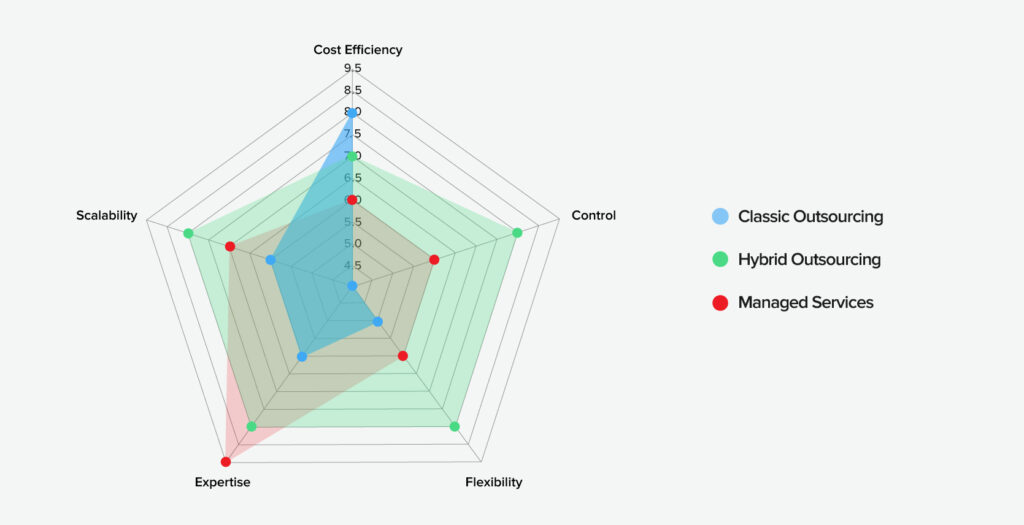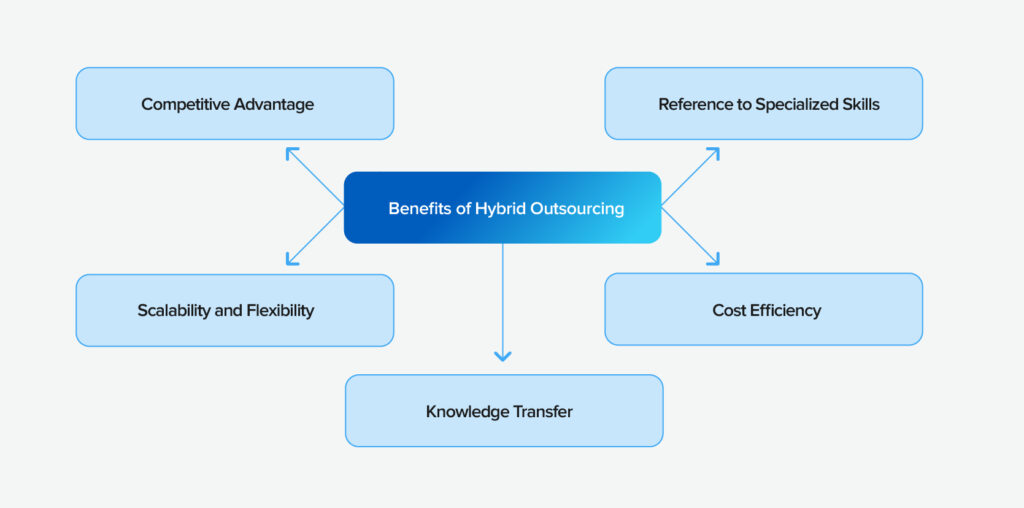They say, “two heads are better than one”, and there’s a good reason for that. The idea of having professionals in every single field on your in-house team is nearly impossible. Different needs may arise during the workflow, and IT teams are no exception. Let’s say you’re launching a new project that requires specific IT expertise, but the project won’t last forever. Hiring new employees for this purpose seems like the best option. However, an external team of experts from a reputable company that seamlessly integrates into your business workflow is a much better choice. Wondering why?
In this article, you’ll get a comprehensive overview of what a hybrid outsourcing model is, its key benefits for your business, and practical tips for building your hybrid team for maximum efficiency.
Hybrid Outsourcing Model: What It Is and How It Works
Outsourcing, in general, is about finding smarter approaches to getting things done. Its goal is to enhance clarity, manage costs, and ensure consistency across your operations, among other benefits. But the world is evolving, so outsourcing now serves as an umbrella term for various collaboration models. Here’s a breakdown of the most used operating business models today.
| Classic Outsourcing | Hybrid Outsourcing | Managed Services | |
| Characteristics | Transfers specific tasks or processes to third-party providers, focusing on cost reduction. Limited client control, standardized processes, and minimal collaboration. | Combines in-house and outsourced resources, blending control with cost efficiency. Offers flexibility, collaboration, and tailored solutions, combining external expertise with in-house oversight. | Fully managed solutions where the provider takes end-to-end responsibility for specific functions. Focus on expertise and outcomes, with less client involvement. |
| Examples | - IT support call centers - Payroll processing - Data entry services | - Software development with internal supervision and offshore coders - Hybrid cloud management - Co-managed customer support teams | - Managed IT infrastructure - Cloud hosting services - Cybersecurity monitoring |
For a better understanding of the difference between these models, here’s a visual explanation:

Benefits of a Hybrid Outsourcing Model for IT Teams
Hybrid outsourcing, as the #1 outsourcing trend in 2025, ensures that both local (onshore) and distant (offshore) teams work together smoothly in Agile projects. The local team focuses on listening to customers and planning, while the offshore team works on completing small parts of the project quickly. This way, the project progresses faster and accomplishes more.

Cost Efficiency
The hybrid outsourcing model helps reduce costs by dividing work among in-house and offshore teams. This way, companies can stick to their budgets while still accessing high-quality expertise. Offshore teams, often based in places like Eastern Europe, can handle complex tasks such as advanced software development or AI work at 40-60% lower costs than onshore teams because of lower labor expenses. Meanwhile, in-house or onshore teams can focus on strategic tasks or client relations to keep everything aligned with business goals. This method combines cost savings with the ability to access global talent for both routine and high-value tasks.
Example: A U.S. company might hire an offshore team in Poland for advanced DevOps work, saving up to 50% while still ensuring quality.
Reference to Specialized Skills
Hybrid outsourcing gives access to a worldwide pool of talent, allowing IT teams to find specialized skills that might not be available locally. The reason for this is that offshore teams often have expertise in areas such as software development, cybersecurity, or data processing, while onshore teams provide local market knowledge or specific industry insights. This setup helps IT teams bring in niche skills without the need to hire full-time specialists in-house.
Example: In 2024, the demand for cybersecurity expertise grew dramatically due to a 75% year-over-year rise in cyber threats, making access to offshore cybersecurity talent particularly valuable.
Scalability and Flexibility
The hybrid outsourcing model offers IT teams flexibility to scale as needed, avoiding the constraints of rigid vendor contracts and fixed staffing levels. Offshore teams typically handle tasks such as software development, data analysis, and cybersecurity, providing cost savings and specialized expertise. Meanwhile, in-house teams facilitate real-time collaboration, strategic oversight, and direct access to stakeholders, which is especially important when adapting to seasonal changes or market fluctuations.
Example: A U.S. company may use an offshore team in India for 24/7 productivity, while the in-house team manages clients and projects.
Knowledge Transfer
Hybrid outsourcing encourages collaboration between in-house and outsourced teams, promoting knowledge sharing and cultural exchange. Regular sessions for knowledge transfer or rotation programs help offshore teams stay aligned with in-house processes, while in-house staff can benefit from global expertise. This approach not only boosts problem-solving skills but also sparks innovation through diverse viewpoints.
Example: Using structured training and asynchronous communication tools like Slack can smooth out the integration process and ensure effective knowledge transfer.
Competitive Advantage
The blend of cost-effectiveness, access to specialized skills, and scalability is what the hybrid outsourcing model brings to IT teams, helping them stay flexible and innovative in a competitive environment. It reduces risks linked to full outsourcing – such as losing control or compromising quality – by keeping core functions in-house while tapping into global talent for efficiency. This approach enables faster time-to-market and greater adaptability, and this is crucial for maintaining a competitive edge.
Example: Companies like Alibaba have utilized hybrid outsourcing to combine offshore web development expertise with their in-house teams. This strategy contributed to rapid growth and notable success, including their record-breaking IPO in 2014.
Challenges of Managing a Hybrid IT Team and Strategies to Overcome Them
Disclaimer: The challenges listed below are easily manageable if they are addressed properly and promptly.
Despite the obvious benefits of adopting a hybrid outsourcing model into your business workflows, it’s important to be aware of the challenges ahead. Since “a danger foreseen is half avoided,” let’s review each of the most likely bottlenecks and strategies to overcome them effectively.
Communication Barriers
Communication and collaboration challenges are a common occurrence for hybrid teams due to the differing work environments. As a result, misunderstandings, delayed responses, or feelings of disconnection among team members hinder collaboration and productivity. For instance, remote workers might miss out on spontaneous office conversations, while in-office staff may struggle to include virtual colleagues in discussions, creating silos or uneven engagement.
✅ Solution:
- Use reliable tools, such as video conferencing (e.g., Zoom), messaging (e.g., Slack), and project management software (e.g., Trello) for seamless interaction.
- Set clear guidelines that define response times, meeting schedules, and preferred channels in a shared team handbook.
- Hold regular check-ins to share updates and resolve issues.
Alignment of Goals
Staying on the same page with goal alignment is another struggle for hybrid teams. Different schedules and work environments can slow the team down due to confusion, mistakes, or conflicting priorities. For example, remote workers might miss important office discussions, while in-office employees might not completely update their virtual teammates.
✅ Solution:
- Set clear goals using easy tools like shared documents or apps (for example, Google Sheets) to define and track team objectives.
- Hold short weekly meetings to review progress, clear up any confusion, and keep everyone focused on what's important.
- Keep all team members involved in planning discussions by using tools like Zoom, so everyone has a voice and stays aligned.
Knowledge Silos
Information can become trapped with certain groups or individuals within the hybrid team. Uneven knowledge sharing causes process delays, rework, and other related issues. For example, in-office staff might hide insights from casual chats, while remote team members may feel excluded from critical updates, creating gaps in team understanding.
✅ Solution:
- Centralize information using shared platforms like Notion or Confluence to store and organize key documents, making it easy for everyone to access the same information.
- Promote open sharing by holding regular knowledge-sharing sessions, such as monthly "lunch and learn" talks via Zoom, to spread insights across the team.
- Encourage cross-team collaboration and transparency to ensure equal access to information through shared drives and by pairing remote and in-office workers on projects using tools like Slack or Miro to foster collective knowledge.
Quality Control
Maintaining consistent quality control is another key challenge for the teams using a hybrid outsourcing model. With limited direct insight into daily tasks, maintaining accountability and overseeing performance can be challenging. Managers need to strike a balance between granting autonomy and providing oversight.
✅ Solution:
- Set clear expectations using SMART (Specific, Measurable, Achievable, Relevant, Time-bound) goals to ensure accountability.
- Emphasize outcomes by assessing results instead of hours worked.
- Offer regular feedback through frequent one-on-one meetings to review progress and resolve issues.
Team Cohesion
Fostering a robust company culture and maintaining employee engagement becomes more challenging in a hybrid setup. The lack of physical closeness can lead to feelings of isolation or disconnection among staff, which can undermine trust and team spirit. For example, remote employees might miss spontaneous interactions and casual conversations in the office that foster friendships among those physically present, which could lead to a sense of division.
✅ Solution:
- Promote informal communication by establishing spaces for casual interactions and hosting virtual team-building activities.
- Acknowledge achievements by celebrating individual and team successes to enhance morale.
- Lead by example – demonstrate expected behaviors and consistently convey company values and objectives.
Vendor Management
Not only different schedules, but also communication styles and access to updates can cause misunderstandings, delays, or missed vendor needs. For example, remote team members might miss important discussions that happen in the office, while in-office staff might assume vendors are informed, leading to coordination gaps.
✅ Solution:
- Centralize communication with shared platforms like Slack to log vendor interactions and updates.
- Set clear expectations by creating standardized vendor agreements and schedules, shared via tools like Google Docs, to align on deliverables and timelines.
- Schedule regular touchpoints, such as weekly check-ins with vendors and team members via Zoom to review progress, address issues, and maintain strong relationships.
Best Practices for Building a Successful IT Team Using Hybrid Outsourcing
Before you, as a business owner or manager, start building a hybrid team for your project, there are several important questions you need to answer:
- What specific skills or expertise does my business lack for this particular project?
- Which business collaboration model would be the best fit? (based on the answer to question #1)
- Which outsourcing company provides team extension services that match our project needs?
- What communication tools and protocols will ensure seamless interaction between teams?
- What measures will the partner implement to protect my data and ensure regulatory compliance?
Based on the answers you get, this is what your path to launching a successful hybrid team looks like: Evaluating business needs → Selecting the appropriate model → Picking an outsourcing service provider → Developing a collaboration framework → Implementing security and compliance measures.
But that’s not all. We’ve compiled a list of best practices to help you maximize the benefits of a hybrid outsourcing model and assemble your ideal IT team for successful business projects.
#1: Establish Well-Defined Roles and Responsibilities
Clear roles form the foundation for success even within a monolithic in-house team, not to mention hybrid models. To effectively address this:
- Use tools like Responsibility Assignment Matrix (RACI charts) to define tasks, assign accountability, and clarify decision-making authority.
- Conduct regular role reviews to ensure alignment with evolving project requirements.
- Set clear expectations because this is the best way to empower team members to take ownership.
- Document responsibilities in shared platforms to improve transparency.
- Conduct open discussions to clarify any ambiguities that might arise during project development.
#2: Create Effective Communication Channels
Effective communication is the driving engine of hybrid teams. To successfully bridge the gap between off-shore and on-shore team members:
- Use tools like Slack or Microsoft Teams for seamless interaction.
- Consider asynchronous communication for diverse time zones.
- Organize regular check-ins and use virtual whiteboards to foster collaboration.
- Choose secure, reliable platforms to keep the workflow smooth and uninterrupted.
#3: Foster a Cohesive Team Culture
Physical distance does not prevent maintaining a unified team culture. Shared values, regular virtual team-building activities, and inclusive decision-making – these are what create a sense of belonging. To ensure these are in place within your hybrid team:
- Model inclusivity
- Encourage open dialogue
- Recognize contributions equally (whether from remote or in-office members)
- Celebrate milestones
- Host virtual coffee chats
| Pro tip Always communicate company goals clearly to promote alignment and show empathy when helping with individual challenges. |
#4: Maintain Proper Knowledge Sharing and Ensure Security
Knowledge is power, but transferring this knowledge might become a real challenge for hybrid teams, particularly data security. To successfully address this challenge:
- Use centralized platforms like Confluence to streamline documentation and ensure easy access to critical information.
- Conduct regular training sessions to bridge skill gaps and mentorship programs to facilitate expertise sharing.
- Leverage encrypted tools and strict access protocols to protect sensitive data, especially in remote setups.
- Perform regular audits and establish clear guidelines to minimize risks.
- Foster a culture of knowledge sharing and prioritizing secure systems to maintain operational continuity and trust.
#5: Track Performance and Accountability
To ensure effective performance monitoring for hybrid teams, it’s crucial to set clear, measurable goals and give transparent feedback. Consider tools like Asana for task tracking and hold regular check-ins to maintain alignment without micromanaging. Other tips include:
- Setting expectations that balance flexibility and accountability.
- Establishing consistent performance metrics for remote and in-office workers to avoid bias.
- Holding regular one-on-ones and team reviews for constructive feedback and early problem-solving.
- Focusing on outcomes over hours worked.
Hybrid Outsourcing Model in Action: Case Studies
Practice makes perfect, which is why the following practical use cases of Svitla services will be the most helpful for your understanding of the value a hybrid outsourcing model can bring to your organization.
E-commerce & Retail
Airship, a company focused on optimizing mobile app experiences, aimed to build an IT system that handles the full lifecycle of mobile apps. They also wanted to develop customer analytics with A/B testing for both mobile and web applications and migrate data storage to a Big Table system. To achieve these objectives, including partner integrations for clients, Airship collaborated with an external team of experts from Svitla Systems.
| Svitla’s solutions | Results |
| - Building native libraries using Java for Android and Objective-C for iOS - Developing SDKs and an API for A/B testing, event, and metric collection across platforms - Analyzing user feedback on push messages and interface designs - Transitioning data storage to Big Table for improved performance. | - Increased sales through A/B testing and feature flags - Simplified SDK integration for Android, iOS, and web platforms - Enhanced system performance with Big Table storage - Code-free app interface modifications and custom source code generation. |
Read the full case study here.
Human Resources
GoodHire, which offers a comprehensive suite of employment screening services, aimed to implement a unique startup concept tailored to each client's needs. Essentially, they needed to build the product from the ground up and ensure an intuitive platform with production-level stability. The company was seeking a professional team extension for this purpose, so they chose Svitla Systems.
| Svitla’s solutions | Results |
| - Forming a dedicated team of 33 developers and QA experts - Defining functional specifications and building the platform from the ground up - Revamping the UI with new layouts for enhanced usability - Conducting test-driven development, system maintenance, and rigorous QA. | - Product launch ahead of schedule - Rapid user engagement, converting initial visitors into customers - 10% monthly growth in loyal users with high satisfaction - Reduced level of user error reports, which improves system reliability. |
Read the full case study here.
Healthcare & Life Science
StatLine, a leader in technology solutions for organ, tissue, and eye donation and transplantation, aimed to develop a system to manage the entire transplantation process from referral to completion. The company needed to increase call center information processing efficiency, implement unified user authentication across platforms, and reduce maintenance costs while improving system reliability. Svitla Systems became the top outsourcing provider for StatLine to help them achieve their business goals.
| Svitla’s solutions | Results |
| - Using AngularJS for front-end and C# with .NET for back-end development - Designing modern software and user interfaces - Migrating to Azure cloud for optimized storage and cost efficiency - Enhancing security with Azure and .NET standards, OAuth, and Security Token Server - Integrating third-party APIs for call data extraction and metadata search. | - A comprehensive system for managing the transplantation process - Improved audio data search and storage with tags and metadata for faster performance - Enhanced user access control and cybersecurity - Reduced monthly on-premises infrastructure maintenance costs. |
Read the full case study here.
Summing Up
Each company’s structure and goals differ, so when selecting the operating business model for your organization’s processes, it’s essential to consider specific needs. However, one thing is certain: a custom combination of methods is usually better than a traditional, one-size-fits-all approach. The hybrid outsourcing model enables your organization to assemble a team perfectly suited to a specific project or business goal.
As a market leader in IT outsourcing, Svitla provides:
- Experienced, top-tier experts
- Full process transparency
- Reasonable budget with no hidden costs
Contact us to get a detailed overview of how a professional team extension can help your business boost productivity, cut project delivery timelines, and ensure high-quality results.





